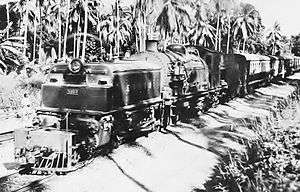EAR 58 class
East African Railways 58 class|

5803 at Changamwe, Kenya, with the Mombasa–Kampala mail train, circa 1950-51 |
| Type and origin |
|---|
| Power type |
Steam |
|---|
| Designer |
|
|---|
| Builder |
Beyer, Peacock & Co. |
|---|
| Serial number |
7290–7307 |
|---|
| Build date |
1949 |
|---|
| Total produced |
18 |
|---|
|
| Specifications |
|---|
| Configuration |
4-8-4+4-8-4 Garratt |
|---|
| UIC class |
(2′D2′)(2′D2′) h4 |
|---|
| Gauge |
1,000 mm (3 ft 3 3⁄8 in) |
|---|
| Driver dia. |
54 in (1,372 mm) |
|---|
| Width |
114 in (2,900 mm) |
|---|
| Adhesive weight |
94 long tons (96 t) |
|---|
| Loco weight |
186.25 long tons (189.24 t) |
|---|
| Fuel type |
Oil |
|---|
| Fuel capacity |
2,375 imp gal (10,800 l; 2,852 US gal) |
|---|
| Water cap |
6,000 imp gal (27,000 l; 7,200 US gal) |
|---|
Firebox:
• Firegrate area |
48.5 sq ft (4.51 m2) |
|---|
| Boiler pressure |
225 psi (1.55 MPa) |
|---|
| Heating surface |
2,561 sq ft (237.9 m2) |
|---|
| • Tubes |
1,963 sq ft (182.4 m2) |
|---|
| • Firebox |
169 sq ft (15.7 m2) |
|---|
Superheater:
|
|
|---|
| • Type |
Inside |
|---|
| • Heating area |
429 sq ft (39.9 m2) |
|---|
| Cylinders |
4 |
|---|
| Cylinder size |
16.5 in × 26 in (419 mm × 660 mm) |
|---|
| Valve gear |
Walschaerts |
|---|
| Valve type |
Trunk type |
|---|
| Valve travel |
5 in (130 mm) |
|---|
| Loco brake |
Westinghouse type |
|---|
| Train brakes |
Westinghouse type |
|---|
| Safety systems |
3 Ross muffled pop valves |
|---|
|
|
|
| Career |
|---|
| Operators |
East African Railways (EAR) |
|---|
| Class |
58 class |
|---|
| Number in class |
18 |
|---|
| Numbers |
5801–5818 |
|---|
| First run |
1949 |
|---|
| Disposition |
All scrapped |
|---|
|
The EAR 58 class was a class of 1,000 mm (3 ft 3 3⁄8 in) gauge 4-8-4+4-8-4 Garratt-type articulated steam locomotives built by Beyer, Peacock & Co. in Manchester, England, in 1949.
The eighteen members of the class were ordered by the Kenya-Uganda Railway (KUR) immediately after World War II, and were a slightly modified, oil-burning version of the KUR's existing coal-fired EC3 class. By the time the new locomotives were built and entered service, the KUR had been succeeded by the East African Railways (EAR), which designated the coal-fired EC3s as its 57 class, and the new, oil-burning EC3s as its 58 class.
Class list
The numbers and build dates of each member of the class were as follows:
Builder's
number |
Built |
KUR
number |
EAR
number |
Notes |
|---|
| 7290 |
1949 |
89 |
5801 |
|
| 7291 |
1949 |
90 |
5802 |
|
| 7292 |
1949 |
91 |
5803 |
|
| 7293 |
1949 |
92 |
5804 |
|
| 7294 |
1949 |
93 |
5805 |
|
| 7295 |
1949 |
94 |
5806 |
|
| 7296 |
1949 |
95 |
5807 |
|
| 7297 |
1949 |
96* |
5808 |
First member of class to enter service with EAR number. |
| 7298 |
1949 |
97* |
5809 |
|
| 7299 |
1949 |
98* |
5810 |
|
| 7300 |
1949 |
99* |
5811 |
|
| 7301 |
1949 |
100* |
5812 |
|
| 7302 |
1949 |
101* |
5813 |
|
| 7303 |
1949 |
102* |
5814 |
|
| 7304 |
1949 |
103* |
5815 |
|
| 7305 |
1949 |
104* |
5816 |
|
| 7306 |
1949 |
105* |
5817 |
|
| 7307 |
1949 |
106* |
5818 |
|
| * KUR number allocated but not carried |
|
See also
References
Notes
Bibliography
- Durrant, A E (1981). Garratt Locomotives of the World (rev. and enl. ed.). Newton Abbot, Devon, UK; North Pomfret, Vt, USA: David & Charles. ISBN 0715376411.
- Patience, Kevin (1976). Steam in East Africa: a pictorial history of the railways in East Africa, 1893-1976. Nairobi: Heinemann Educational Books (E.A.) Ltd. OCLC 3781370.
- Ramaer, Roel (1974). Steam Locomotives of the East African Railways. David & Charles Locomotive Studies. Newton Abbot, Devon, UK; North Pomfret, Vt, USA: David & Charles. ISBN 0715364375.
- Ramaer, Roel (2009). Gari la Moshi: Steam Locomotives of the East African Railways. Malmö, Sweden: Stenvalls. ISBN 9789172661721.
- Staff writer (February 1957). "The "58" Class Locomotives" (PDF). East African Railways and Harbours Magazine. East African Railways and Harbours. 3 (1): 20. Retrieved 8 December 2014.
External links
 Media related to Steam locomotives of Kenya at Wikimedia Commons
Media related to Steam locomotives of Kenya at Wikimedia Commons
![]() Media related to Steam locomotives of Kenya at Wikimedia Commons
Media related to Steam locomotives of Kenya at Wikimedia Commons